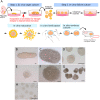A way for in vitro/ex vivo egg production in mammals
- PMID: 31006727
- PMCID: PMC6708856
- DOI: 10.1262/jrd.2019-024
A way for in vitro/ex vivo egg production in mammals
Abstract
Eggs are female germ cells that are required for producing offspring through sexual reproduction. In mammals, eggs are produced in the ovary and ovulated into the oviduct. It is well known that over 99% of eggs are degenerated without ovulation, so that many studies have attempted in vitro folliculogenesis to produce many eggs in different species for a few decades. Although many methods have been developed, a success of in vitro egg production with the resultant live birth of offspring has been limited, especially in livestock animals. More recently, we have succeeded in producing live pups derived from in vitro/ex vivo egg production in mice. This review aims to introduce our recent findings with a brief history of in vitro/ex vivo culture systems for follicles and ovaries.
Keywords: Folliculogenesis; In vitro egg production; Oogenesis.
Figures


Similar articles
-
Update on oogenesis in vitro.Minerva Ginecol. 2018 Oct;70(5):588-608. doi: 10.23736/S0026-4784.18.04273-9. Epub 2018 Jul 10. Minerva Ginecol. 2018. PMID: 29999288 Review.
-
[Reconsidering the roles of female germ cells in ovarian development and folliculogenesis].Biol Aujourdhui. 2011;205(4):223-33. doi: 10.1051/jbio/2011022. Epub 2012 Jan 19. Biol Aujourdhui. 2011. PMID: 22251857 Review. French.
-
Successful in vitro culture of pre-antral follicles derived from vitrified murine ovarian tissue: oocyte maturation, fertilization, and live births.Reproduction. 2011 Feb;141(2):183-91. doi: 10.1530/REP-10-0383. Epub 2010 Nov 12. Reproduction. 2011. PMID: 21075829
-
The earliest stages of folliculogenesis in vitro.Reproduction. 2002 Feb;123(2):185-202. doi: 10.1530/rep.0.1230185. Reproduction. 2002. PMID: 11866686 Review.
-
Prospects for new oocyte-based assisted reproduction in animals and humans.Reprod Fertil Dev. 2019 Jan;32(2):7-10. doi: 10.1071/RD19271. Reprod Fertil Dev. 2019. PMID: 32188554 Review.
Cited by
-
WNT signaling in pre-granulosa cells is required for ovarian folliculogenesis and female fertility.Development. 2021 May 1;148(9):dev198846. doi: 10.1242/dev.198846. Epub 2021 Apr 29. Development. 2021. PMID: 33914868 Free PMC article.
-
Insights into in vivo follicle formation: a review of in vitro systems.Histochem Cell Biol. 2022 Mar;157(3):333-345. doi: 10.1007/s00418-021-02058-w. Epub 2021 Nov 30. Histochem Cell Biol. 2022. PMID: 34846577 Free PMC article. Review.
-
Blocking estrogen-induced AMH expression is crucial for normal follicle formation.Development. 2021 Mar 19;148(6):dev197459. doi: 10.1242/dev.197459. Development. 2021. PMID: 33658225 Free PMC article.
-
Optimization of ovum pick-up-in vitro fertilization and in vitro growth of immature oocytes in ruminants.J Reprod Dev. 2025 Feb 5;71(1):1-9. doi: 10.1262/jrd.2024-091. Epub 2024 Dec 22. J Reprod Dev. 2025. PMID: 39710384 Free PMC article. Review.
-
Effect of in vitro growth on mouse oocyte competency, mitochondria and transcriptome.Reproduction. 2021 Sep 9;162(4):307-318. doi: 10.1530/REP-21-0209. Reproduction. 2021. PMID: 34397394 Free PMC article.
References
-
- Winston RML. The 40th anniversary of human IVF: time to celebrate and time to reflect. Reproduction 2018; 156: E1–E3. - PubMed
-
- Plant TM, Zeleznik AJ, Albertini DF, Goodman RL, Herbison AE, McCarthy MM, Muglia LJ, Richards JS, Knobil E, Neill JD. Knobil and Neill’s Physiology of reproduction. Oxford: Elsevier/Academic Press; 2015: 2 v.
-
- Moore SG, Hasler JF. A 100-Year Review: Reproductive technologies in dairy science. J Dairy Sci 2017; 100: 10314–10331. - PubMed
-
- Herta AC, Lolicato F, Smitz JEJ. In vitro follicle culture in the context of IVF. Reproduction 2018; 156: F59–F73. - PubMed

